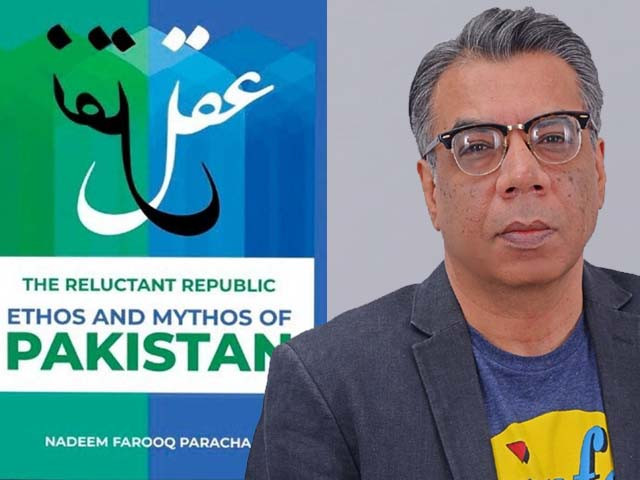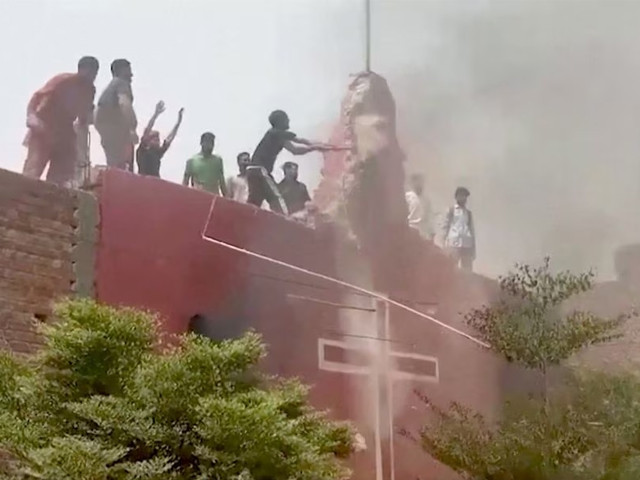
Discussing the ethos and mythos of Pakistan with Nadeem Farooq Paracha
Nadeem Farooq Paracha is one of the most prominent journalists and public intellectuals in Pakistan. Besides being a regular columnist, he has also authored several books. While all his books are distinct, the two common themes of religion and nationalism link them together. His latest book, The Reluctant Republic: Ethos and Mythos of Pakistan, also explores these two themes from another angle. I have had the opportunity to read the book and, since it is a very interesting and thought-provoking one, I decided to interview Paracha in order to get his perspective on some of the key ideas he has explored in this book.
Raza Habib Raja (RHJ): In your new book, The Reluctant Republic, you have stated that most citizens in Pakistan prefer to call themselves Muslims first and then Pakistani later. Can you elaborate as to why this is important for you to examine this in such detail?
Nadeem Farooq Paracha (NFP): It is important because for over seven decades, the state, its ideologues and various governments have put so much effort in trying to formulate an agreeable national identity. Yet they have continued to struggle. It began by positing a nationalism which meant we are different from Hindus, to we have our roots in Central Asia, to we are part of a larger Muslim ummah. In this pursuit, we divorced ourselves from the reality that as a country, we are situated in South Asia and share a long history with all the other peoples of this region — no matter what their faith, ethnicity, race or nationality. Indeed, nationalism requires the construction of myths and pseudo-histories to turn a community of people into a national whole. It is a conceptual, but also a territorial whole. However, we went a step further by escaping the physical reality of being part of this region. We conceptually transported ourselves somewhere else; first to Central Asia and then Arabia. We spend more time in trying to define what Islam means or should mean in Pakistan, instead of what it means to be Pakistani. We invest more time in debating what is or is not Islamic culture, rather than on what is Pakistani culture. Islam is but one aspect of this culture. And within this are many variants.
By saying we are Muslim first, we are confessing that we are not quite sure what being a Pakistani really means. Ideally, it should mean a community of diverse ethnic, sectarian and sub-sectarian Muslim groups, and non-Muslim minorities, tied to a nationalistic whole and linked to an integrated political and economic system. A Muslim citizen of Egypt calls himself an Egyptian. Same is the case in all other Muslim-majority nation-states. Heck, even the Saudis call themselves Saudis first!
RHR: In your book you write that the founding fathers wanted to relegate religion to the private sphere. How would you support your statement given the fact that some Muslim League leaders during the 1946 election campaign used religious slogans?
NFP: No, what I meant was that Islam as a nationalist project was put in the public sphere, whereas the faith’s more theological aspects were relegated to the private sphere. This is why the Islamist groups opposed the Muslim League. For example, to Abul Ala Maududi, politics was inherent in the theology of Islam, and in order to create a pious polity, Islam needed to be enforced in the public sphere. The founders tended to disagree. Apparently, in 1938, a Muslim League pamphlet appeared which severely criticised the clergy and hoped that they would be vanquished like they were by Kamal Ataturk in Turkey. The Islamist slogans during the 1946 elections were largely heard in rural Punjab, where the League was weak. They weren’t part of the League’s campaigns in Bengal and Sindh.
RHR: But after Partition, the 1949 Objectives Resolution became the blueprint for the subsequent Islamisation drive in Pakistan. The debates in the assembly during that time show that Pakistan’s future Islamic path was chalked out in the early years, and the minorities were ringing the alarm bells right from the beginning.
NFP: Indeed. But we have the benefit of hindsight to see how or what this evolved into. Firstly, if you go through the debates in the Constituent Assembly, you will notice that a prominent Ahmadiyya, Zafarullah Khan, and the progressive Mian Iftikharuddin supported the Resolution. Secondly, what gets missed is the fact that the founders’ idea of Islam was rather different than that of the Islamists. It wasn’t theocratic. However, having said that, I must add that the modernist Muslims who were the main custodians of the movement that created Pakistan failed to formulate a cohesive concept of the supposedly more enlightened, rational and modernist Islam that they were advocating. Instead, they were always at pains to convincingly define it. They spent more effort in trying to co-opt ideas of their opponents, the Islamists.
They believed they would be able to soften these ideas and neutralise the Islamists. They didn’t have the will to take the Islamists head-on. Even after the state crushed an Islamist surge in 1953, in the shape of the anti-Ahmadiyya movement, the ruling elite still believed it could neutralise the Islamists through co-option. The 1953 commotion should have been understood as a failure of this approach. But it continues to this day. It’s a rather delusional ploy.
RHR: In your book you write that the state tried to control Pakhtun nationalism by introducing young people to radical religious and sectarian ideas. Do you think that this strategy by the state was purely reactive? If Pakhtun nationalism did not have secession undertones, then perhaps the state would have also refrained from using this route?
NFP: The monolithic manner in which the state tried to construct a national whole almost immediately created ethnic cleavages. All the decision-making processes were usurped by the Punjabi and Muhajir elites. There is no question of whether Pakhtun, or for that matter, Sindhi, Baloch or Bengali nationalisms would not have appeared. After East Pakistan broke away in 1971, a simplistic narrative was shaped which claimed that East Pakistan was lost because Islam was not engrained enough in the polity and national body. So, Islam, as a non-theocratic nationalist ploy that the founders had employed, was discarded, and a more public and political manifestation of Islam that the Islamists had been propagating was adopted.
Whereas ethnic nationalists were once denounced as traitors, they now began to be labelled as anti-Islam. To facilitate the so-called anti-Soviet jihad in Afghanistan, fought from the Pakhtun areas of Pakistan, it became important for the state to aggressively Islamise the Pakhtun polity. This had an adverse effect on Pakhtun nationalism. It did not have the kind of resources to sustain itself in a region which was now brimming with hundreds of madrassas, Islamist ideologues and militants. The state believed that one outcome of this was the erasure of Pakhtun nationalism. It wasn’t. It was actually the creation of another, even more alarming problem – that of Islamic extremism and militancy.
The state even tried to use the same ploy in Sindh and Balochistan. Whereas Sindh, outside its capital Karachi, has somewhat withstood the onslaught of this nature, things in Balochistan have only worsened. It is a terrible idea.
RHR: You have mentioned that the early years of Pakistan were shaped by the Muslim modernist project, which began to erode after the East Pakistan debacle. Why do you think that specifically the East Pakistan debacle led to its abandonment?
NFP: The so-called East Pakistan debacle can be seen as the defeat of what Dr Mohammad Waseem calls the migrant state. Or a state dominated by refugees who arrived from East Punjab and Uttar Pradesh (UP) in India. Perversely, the East Pakistan loss can also be understood as the rise of the locals. By locals, Dr Waseem means people of the soil who were always here. The locals resented the manner in which the migrants gave all the best positions to themselves in state and government institutions. The migrants thought of themselves as the true custodians of the Pakistan movement and people who had sacrificed more during the creation of Pakistan.
The loss of East Pakistan changed all that. The locals began to assert themselves. The first thing they did was to start discarding notions of politics, nationalism and Islam championed by the migrants. This is why one saw the emergence of ethnic or folk arts on mainstream media, and a greater emphasis on Sufism, parliamentary democracy, restoration of provinces on ethnic basis etc. As a response, the migrant elites tried to revive their influence by replacing their previously modernist strands of Islam with a more theocratic strand, especially from the 1980s onwards.
RHR: You have discussed the way Islam features in the imagination of Pakistan’s urban middle classes. Do you think that economic interests alone explain the reactionary interpretation of Islam in this class?
NFP: Initially, the middle classes were largely made up of the Punjabi and Urdu-speaking migrants. They adopted the modernist-statist ethos of the state that was dominated by them. Therefore, the defeat of the migrant state and the political rise of the locals did not sit well with the middle classes. That’s why they too adopted a more conservative disposition when remnants of the migrant state changed tact and became the custodians of the Islamisation process. It was economically beneficial too because the process was being bankrolled by the United States (US) and the Saudis and facilitated by a military dictatorship led by a migrant from East Punjab.
RHR: While going through the section in your book about the country’s blasphemy laws, one gets the impression that there was no organic public support for the introduction of such laws. Why then were these laws introduced and, more importantly, why have they become completely untouchable?
NFP: There was neither support nor opposition. A softer form of this law was always present in the country’s panel code. But it only came into play 14 times between 1947 and 1987. The core problem resides in the way the death penalty was added to this law in 1986. The demand did not come from the people. The death penalty in this context was not part of any party manifesto. It wasn’t offered as a promise, even during the 1985 elections in which only pro-Zia groups took part. People were not thronging the streets, demanding death to blasphemers.
The idea to introduce the death penalty came from less than a handful of pro-Zia members of the National Assembly as a way to subdue the opposition against his draconian Islamisation projects. Much of the opposition was coming from women’s rights organisations. And it was one particular speech by the late Asma Jehangir against the politicalisation of the ulema which triggered the assembly members. They claimed she had insulted Islam. Now anyone can use this law to put opponents and enemies behind bars or get them murdered by mad mobs.
RHR: You have written that the Jamaat-e-Islami’s founder and its chief ideologue, Maulana Abul A’la Maududi, was instrumental in fusing the idea of state and religion. Why do you think his ideas have found so much traction, all while the party he founded continues to fail at the polls?
NFP: When the state and even non-Islamists began to adopt Maududi Sahib’s ideas, his own party did not have the kind of resources that the state and larger parties had. His party was more of a nursery for urban, middle class Islamists who went on to join either state institutions or larger centre-right parties. By the way, this nursery has also provided a plethora of journalists. However, today, his party is trying to expand its appeal by concentrating more on economic issues. Let’s see how that goes.




COMMENTS
Comments are moderated and generally will be posted if they are on-topic and not abusive.
For more information, please see our Comments FAQ